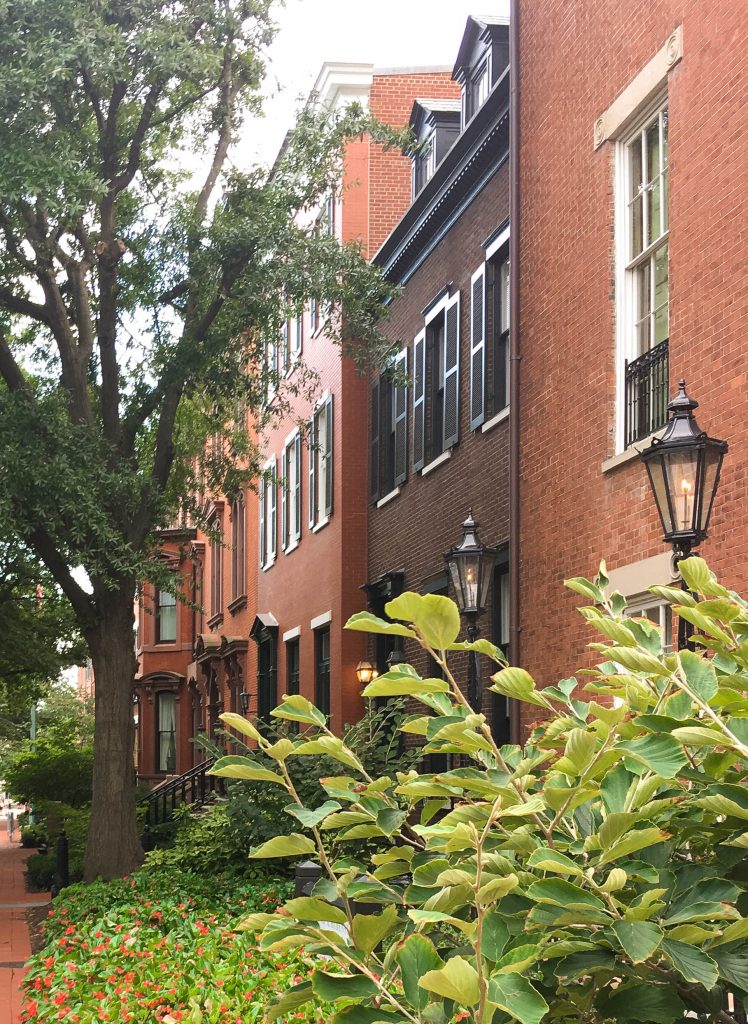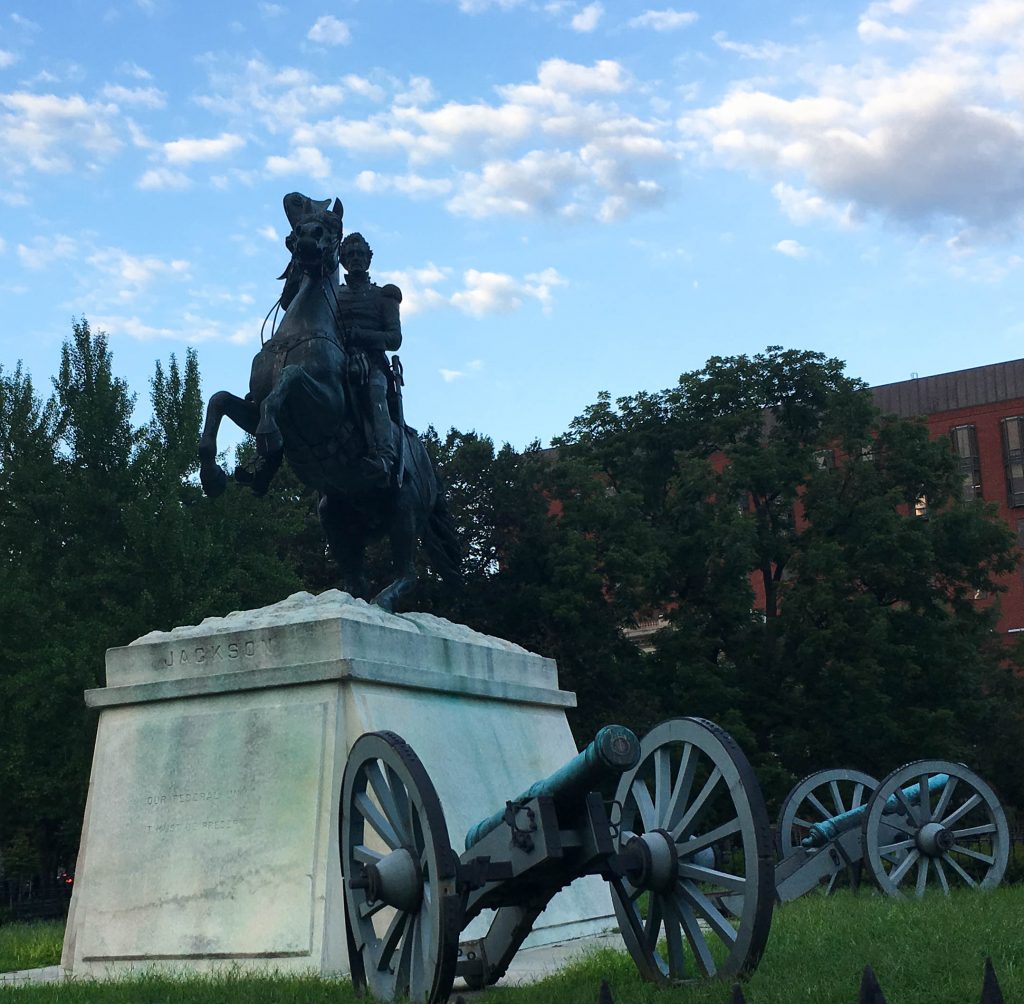Lafayette Square is a seven-acre public park directly across Pennsylvania Avenue from the White House. It is one of the most meaningful areas in American history, where citizens have lived out the freedoms protected by the First Amendment amid statues of the men who won our independence from Great Britain. The Park and its surrounding area was designated a National Historic Landmark District in 1970.
The Park’s central statue depicts (no, not the Marquis de Lafayette) President Andrew Jackson. Standing at its corners are statues of four European generals from the Revolutionary War:
- Major General Jean-Baptiste Donatien de Vimeur, comte de Rochambeau, who commanded the French Expeditionary Force, which sailed from France to aid the Continental Army
- Major General Friedrich Wilhelm von Steuben, General George Washington’s chief-of-staff, who instructed Continental soldiers in military discipline and tactics
- Brigadier General Tadeusz Kościuszko, who engineered defenses throughout the new states, including at Saratoga, site of the turning battle of the War
- Major General Gilbert du Motier, marquis de Lafayette, who commanded Continental troops in several battles, including the decisive Siege of Yorktown
The Square was renamed in honor of the Marquis de Lafayette in 1824, when he returned from France for a tour of all 24 states. It was a good choice. Not all Lafayette Square’s history is glorious. It is likely that slaves were bought and sold there. But the Marquis de Lafayette is one of the most significant early abolitionists on three continents. He urged his friends George Washington, Thomas Jefferson, and others to live out opposition to slavery. After the War, he successfully petitioned the Virginia legislature to emancipate James Armistead, a slave who had served as a double agent during the War, spying on Generals Charles Cornwallis and Benedict Arnold, supplying information that contributed to the Continental Army’s victory at Yorktown. Upon his emancipation, the freed slave renamed himself James Armistead Lafayette. It is believed that the Marquis may have also supplied money that enabled Armistead-Lafayette to buy the freedom of his wife, children, and other relatives over the years.
After returning to France in 1785, Lafayette pursued a practical plan to eliminate slavery. In 1786, he purchased two sugar plantations in the South American colony of Cayenne (French Guiana) with approximately 70 slaves. His idea was to model gradual manumission. He converted the plantations to spice production, which required less demanding labor than sugar. He paid the workers wages, provided schooling for them, and granted them leisure time with their families. He forbade selling slaves as well as the use of the whip for punishing them. He thought that these reforms would prepare the workers for freedom and show the world how emancipation could work. Meanwhile, representing the nobility in the Estates General, Lafayette advocated legally abolishing slavery. Unfortunately, the French Revolution got in the way. Before he could implement his plan for gradual manumission, Lafayette was thrown in prison in Austria. His plantations were confiscated under Robespierre, and the slaves were sold. France did abolish slavery in 1794, but the institution was reinstated by Napoleon in 1802. Still, France ultimately abolished slavery in 1848, fifteen years before America did.
This post contains affiliate links. For more information, click here.
Significant buildings along Lafayette Square include:
- St. John’s Church. The stuccoed brick building was built in 1815 and designated a National Historic Landmark in 1960. It features 25 historic stained-glass windows and a 1,000-pound bell cast by Paul Revere’s son Joseph at his foundry in Boston. It has been dubbed “the church of the presidents” because every sitting president since James Monroe has attended a service there. During the Civil War, Abraham Lincoln would sometimes attend evening prayer there.
- The Hay-Adams Hotel. The luxury property is a member of the Historic Hotels of America. It houses a classic bar reminiscent of the Coq d’Or at the Drake in Chicago and a top-floor event space with spectacular views of Washington.
- Decatur House. Constructed in 1818, the building is now the site of the National Center for White House History. But it was built as a private residence for War of 1812 naval hero Stephen Decatur and his wife Susan and briefly the site of the ambitious couple’s lavish parties. But after the Commodore was killed in a duel in 1820, his widow rented the place out. Over the years, it would be home to a string of notables, including several Secretaries of State like Martin van Buren and Henry Clay, and their slaves. In 1829, a slave named Charlotte Dupuy unsuccessfully sued Clay for her freedom and that of her children while living in the house.
- Blair House. Also called “the President’s Guest House”, the complex hosts high-level visiting dignitaries. Guests have included Queen Elizabeth, Margaret Thatcher, and Charles de Gaulle. It is also traditionally occupied by the incoming President and First Lady in the days before Inauguration.
Beginning in the 1950s, the architectural character of the district came under threat from a movement to raze some of the historic buildings and erect modern government offices. In 1962, First Lady Jacqueline Kennedy ignited a successful effort to preserve the buildings and their sense of heritage. In one letter, she stressed the importance of “preserving our nation’s past”, including “the 19th Century feeling of Lafayette Square”, and noted her “panic at the thought” of such historic buildings “being ripped down and horrible things being put up in their place”. She not only saved the character of Lafayette Square but also raised public support for historic preservation in general.
But Lafayette Square is important to America’s heritage in ways far beyond architecture. Situated across from the White House, it’s an ideal location for political protest. The earliest demonstrators were suffragettes, demanding that President Woodrow Wilson support votes for women. They were beaten by passers-by. Sometimes the police watched these attacks. Sometimes they arrested the protesters and locked them in jails, where they were given dirty bedding and insect-infested food, and sometimes beaten to the point of torture. The treatment of the women and the violations of the First Amendment helped move public sympathy toward their cause.
And they started a trend that has lasted for decades. Over the years, groups on every side of virtually every issue have demonstrated in Lafayette Square. In college, I attended rallies there in support of President Ronald Reagan’s successful efforts to defeat the Soviet Union. I was there on November 3, 1983, chanting “Run, Ronnie, Run!” with my friends, and we were thrilled to catch a glimpse of the President and Mrs. Reagan waving from behind a White House window. Hours later, President Reagan announced his intention to run for re-election. (It was a real nail-biter, and I’m sure our rally was the tipping point.)
Lafayette Square is the heart and soul of America, the heritage of our early Republic, and the home field of the First Amendment.
After my misspent youth as a wage worker, I’m having so much more fun as a blogger, helping other discerning travellers plan fun and fascinating journeys. Read more …


